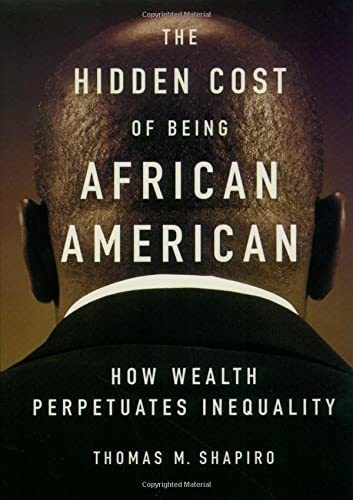Book : The Hidden Cost Of Being African American How Wealth
Pagá en cuotas
Disponible 25 días después de tu compra
MercadoLíder | +10mil ventas
MercadoLíder Platinum
+10mil
Ventas concretadas
Brinda buena atención

Descripción
- ANTES DE COMPRAR PREGUNTE FECHA DE ENTREGA.
- ENVIAMOS POR MERCADOENVIOS
- PUEDE RETIRAR POR AHORA SOLO POR QUILMES, MICROCENTRO ESTA CERRADO, POR ESO...
- EN CABA (CAPITAL FEDERAL) ENVIAMOS SIN CARGO ESTE PRODUCTO.
- FORMA DE PAGO : MERCADOPAGO
- HACEMOS FACTURA A.
- ELBAZARDIGITAL VENDEDOR PLATINUM
- TODOS NUESTROS PRODUCTOS EN:
https://eshops.mercadolibre.com.ar/elbazardigital
-X-X-X-
- SOMOS IMPORTADORES DIRECTOS, ESTE PRODUCTO SE COMPRA Y SE IMPORTA DESDE ESTADOS UNIDOS, ESTO IMPLICA QUE USTED ESTA COMPRANDO EL MISMO PRODUCTO QUE COMPRARÍA UN CLIENTE DE ESE PAÍS.
- ANTES DE REALIZAR UNA CONSULTA, VISUALICE TODAS LAS IMAGENES DEL PRODUCTO.
Descripción provista por la editorial :
Over the past three decades, racial prejudice in America has declined significantly and many African American families have seen a steady rise in employment and annual income. But alongside these encouraging signs, Thomas Shapiro argues in The Hidden Cost of Being African American, fundamentallevels of racial inequality persist, particularly in the area of asset accumulation--inheritance, savings accounts, stocks, bonds, home equity, and other investments-. Shapiro reveals how the lack of these family assets along with continuing racial discrimination in crucial areas like homeownershipdramatically impact the everyday lives of many black families, reversing gains earned in schools and on jobs, and perpetuating the cycle of poverty in which far too many find themselves trapped. Shapiro uses a combination of in-depth interviews with almost 200 families from Los Angeles, Boston, and St. Louis, and national survey data with 10,000 families to show how racial inequality is transmitted across generations. We see how those families with private wealth are able to move up fromgeneration to generation, relocating to safer communities with better schools and passing along the accompanying advantages to their children. At the same time those without significant wealth remain trapped in communities that dont allow them to move up, no matter how hard they work. Shapirochallenges white middle class families to consider how the privileges that wealth brings not only improve their own chances but also hold back people who dont have them. This wealthfare is a legacy of inequality that, if unchanged, will project social injustice far into the future. Showing that over half of black families fall below the asset poverty line at the beginning of the new century, The Hidden Cost of Being African American will challenge all Americans to reconsider what must be done to end racial inequality. From Publishers Weekly Shapiro, coauthor of Black Wealth/White Wealth, has helped establish that the racial gap in wealth-i.e., assets, including property-is more enduring than the gap in income. That gap, a 10-fold ratio, is exemplified by what the author terms transformative assets-gifts, from parents and others, that work to lift succeeding generations economically and socially beyond their own achievements. Interviews with black, white and Hispanic families in Boston, Los Angeles and St. Louis show families with similar incomes living in stratified neighborhoods (and better school districts) thanks to parental help. Most of the white interviewees dont recognize the role of Shapiros form of privilege in their lives, while middle-class blacks report far more issues with needy parents, relatives and friends. Shapiro, who holds a chair in law and social policy at Brandeis, also shows why it costs more for blacks to buy homes: discrimination in credit, higher interest rates (whites have more capacity to pay points) and depressed home values caused by residential segregation all contribute. At the same time, Shapiro says, policies such as the federal tax break on mortgage interest perpetuates inequality by making the relatively rich richer. He proposes several class-based, tax-eased solutions at the federal level that go beyond social security: childrens savings accounts; individual development accounts that match savings; and down payment accounts to help buy homes, drawn from a partial tax credit for renters. Such policies, he reminds us, would hardly be outlandish; they echo previous asset-building policies such as the Homestead Act, the GI Bill and Veterans Administration home loans. A reformed estate tax, he argues, would also help move toward fairness. With all the data Shapiro convincingly pulls together, this should be an essential document for policy groups and could reframe the debate around affirmative action and reparations. Copyright © Reed Business Information, a division of Reed Elsevier Inc. All rights
-o-o-o-
Garantía del vendedor: 90 días
Preguntas y respuestas
¿Qué querés saber?
Preguntale al vendedor
Nadie hizo preguntas todavía. ¡Hacé la primera!

